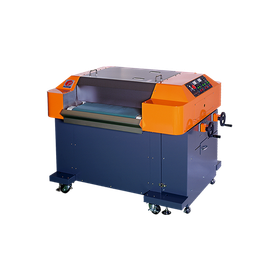The four heating rolls can independently adjust the temperature! It can memorize three patterns of combinations.
The "SDX-700A" is a high-end tabletop laminator that achieves detailed thermal management with a newly developed non-contact sensor and temperature control board. It comes standard with a wired remote control (smart controller), allowing control of operations such as temperature, transport, and emergency stop from the back. It is equipped with connection terminals and power terminals that make it easy to upgrade to a full or semi-automatic system when combined with the "TAF-700" and "TAC-700". 【Features】 ■ Increased diameter of the laminate roll improves thermal efficiency and further enhances quality. ■ Improved curl prevention device for one-sided PP processing enhances post-processing workability. ■ Optional cold separator winding device available. ■ Pressure fine-tuning mechanism, thermal roll shielding plate, cooling fan, and more. ■ Capable of system upgrades by connecting dedicated feeders, cutters, etc. *For more details, please refer to the PDF document or feel free to contact us.
Inquire About This Product
Related Videos
basic information
【Features (Excerpt)】 ■ Roll effective width: 700mm ■ Maximum paper size: A1/Chrysanthemum full vertical/Width 670mm, length irregular ■ Usable finishes: PP single-sided/double-sided/PET double-sided/cold (optional) ■ Maximum film size: Width 670mm × Diameter 300mm φ ■ Heating method: 2-stage rotary built-in far-infrared heater ■ Temperature control device: Non-contact sensor measurement type TOLAMI original temperature controller *For more details, please refer to the PDF document or feel free to contact us.
Price range
Delivery Time
Applications/Examples of results
For more details, please refer to the PDF document or feel free to contact us.
catalog(3)
Download All CatalogsCompany information
Tokyo Laminex Co., Ltd. has been a pioneer in laminating since its establishment, continuously developing and researching technologies related to "desktop laminating machines, laminating films, and laminating processing," and has always led the industry. We have successfully achieved laminating photographs, which has traditionally been considered very difficult, and established high-quality laminating that does not compromise the texture of the material, completely changing the conventional image of laminating. This technology has also expanded to accommodate various digital outputs due to the spread of personal computers, in addition to photographic paper.











![Deburring Machine "Twin Baritor" [Eligible for Small and Medium Enterprise Productivity Investment Subsidy]](https://image.mono.ipros.com/public/product/image/6d3/2000308654/IPROS16685940644635288329.png?w=280&h=280)


